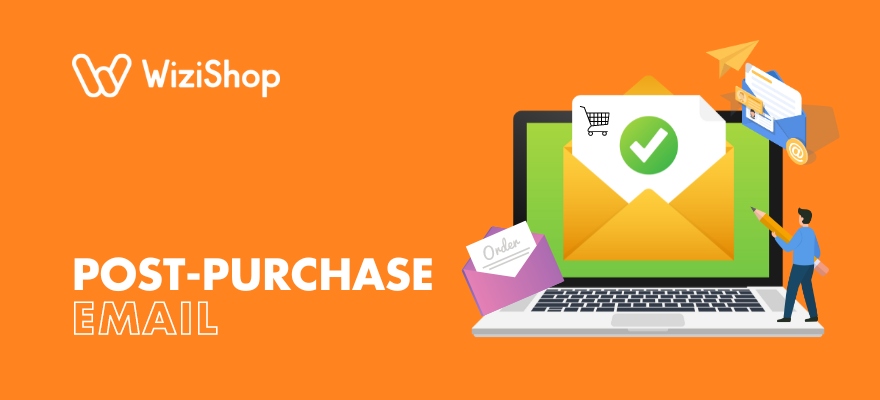Being the owner of an online store, you likely put a decent amount of time into building brand awareness and encouraging shoppers to buy products from your site via various email marketing tactics. After a visitor has finalized an order, you might be thinking that your email marketing efforts are complete... After all, you've closed the sale, right?
In reality, however, there's still work to be done in order to strengthen customer relationships and keep people coming back for future purchases.
When it comes to ecommerce, post-purchase emails are more than just a courtesy; they're a vital part of enhancing customer experience and boosting brand loyalty. From order confirmations to requests for reviews, these communications keep customers engaged and informed long after they've clicked the "Buy" button.
In this article, we explore the art of crafting effective post-purchase emails, featuring practical examples and highlighting best practices that ensure your email campaigns resonate with recipients and encourage repeat business.
Whether you're looking to refine your current strategy or build one from scratch, the insights here offer valuable guidance on nurturing customer relationships through thoughtful, well-timed email communications!
What is a post-purchase email?
A post-purchase email is a type of communication sent to customers after they have completed a purchase, aimed at enhancing the customer experience and building long-term relationships.
These automated emails can confirm order details, provide shipping updates, and acknowledge receipt. They also serve as a tool for engaging customers further by soliciting feedback, offering discounts on future orders, or suggesting related products (cross-selling).
Effective post-purchase emails reinforce brand loyalty, encourage repeat business, and increase customer satisfaction by keeping the buyer informed and engaged throughout the post-purchase phase.
Benefits of post-purchase emails for your ecommerce business
As a busy ecommerce entrepreneur, there's a good chance that you have a lot on your plate. You may be wondering if putting in the effort to craft an effective post-purchase email strategy is really necessary. The answer is a resounding YES!
Post-purchase emails offer several benefits for ecommerce brands:
- Enhances the customer experience: Post-purchase emails keep customers informed about their order status, contributing to a transparent and trustworthy shopping experience.
- Increases customer retention: Regular communication through post-purchase emails helps maintain a connection with the customer, encouraging repeat purchases and loyalty.
- Encourages feedback and reviews: These emails can prompt customers to supply valuable feedback or write product reviews, which can boost credibility and attract new customers.
- Supplies an opportunity for cross-selling and upselling: By suggesting related products or upgrades, post-purchase emails can generate additional revenue and enhance the customer’s overall satisfaction with their purchase.
- Improves communication: Post-purchase emails provide a direct line of communication for addressing any issues or concerns, improving overall customer service.
- Allows for brand reinforcement: Every email serves as an opportunity to strengthen brand recognition and affinity through consistent branding and tailored messages.
- Facilitates customer segmentation: Insights gathered from customer interactions with post-purchase emails can help segment customers based on their behavior, leading to more personalized marketing efforts.
- Is cost-effective marketing: Email marketing in ecommerce, including post-purchase emails, remains a cost-effective strategy with a potentially high return on investment due to its direct and personalized nature.
- Increases customer lifetime value (CLV): By nurturing the customer relationship beyond the initial purchase, businesses can increase the total value derived from each customer over time.
- Collects data and insights: These emails can be a source of valuable data about customer preferences and behaviors, guiding future marketing strategies and product offerings.
Examples of post-purchase emails to include in your campaigns
Post-purchase emails can be categorized into several types based on their purpose and content. Here’s a breakdown of the main categories:
- Transactional emails: These emails are essential for providing customers with important information about their recent transaction. Common types include order confirmations, shipping notifications, and delivery confirmations. Their primary function is to keep the customer informed about the status of their purchase and to provide essential details such as order numbers, tracking information, and expected delivery dates.
- Sales-oriented emails: This category aims to drive additional sales through tactics such as cross-selling and upselling. Examples include emails that recommend products related to the original purchase, offer special discounts on future orders, or invite customers to exclusive sales. These emails leverage the initial purchase as an opportunity to enhance the customer's experience and increase their lifetime value.
- Feedback and review requests: After a customer has received their product and had some time to use it, sending emails that ask for feedback or a review is common. These emails are crucial for gathering customer insights and testimonials, which can improve product quality, customer service, and enhance social proof on ecommerce platforms.
- Engagement and loyalty emails: Designed to build and maintain a relationship with the customer, these emails might include membership or loyalty program invitations, customer surveys, or newsletters. They keep the brand top-of-mind and often provide customers with added value through content, such as usage tips, company news, or community activities.
- Educational and onboarding emails: For more complex products or when a purchase marks the beginning of a subscription or service, onboarding emails help guide customers on how to best use the product or service. Educational emails can provide tips, tutorials, and other resources to enhance the customer's experience and satisfaction.
To further guide your strategy, check out the following examples of different kinds of post-purchase emails you might send to your online store's customers.
1. Order confirmation email
The first type of communication that you'll send in your series of post-purchase emails is an order confirmation.
This is sent immediately after a purchase to confirm the transaction. It typically includes order details such as the products purchased, prices, and the order number, reassuring the customer that their transaction was successful.
Today's online shoppers have come to expect this communication after placing an order. If you forgo this crucial confirmation email, your customers may worry that their purchases didn't go through and lose trust in your store.
With an open rate of 58.7%, according to Omnisend, order confirmations are highly anticipated by consumers, further proof that you can't neglect them in your marketing strategy. Whether after a first purchase, a third purchase, or beyond, every order confirmation you send should supply all the pertinent details for the shopper's order.
Take a look at this email confirming an order from the Chewy website, for example. It features a summary of all the items in the order, along with clear pricing. In addition, it displays the customer's shipping address and provides contact information for the recipient in case of any questions or concerns regarding the order. Finally, there's a call-to-action (CTA) button, allowing the shopper to return to the website to view their order status if they so choose.

Source: Really Good Emails
2. Thank-you email
Thank-you emails are often combined with order confirmations but are sometimes sent separately. Similar to welcome emails, they serve as a way to show your customers your appreciation for their orders as well as share a bit more about your brand.
While order confirmations are expected, receiving a thank-you message from your company can be a pleasant surprise for shoppers and make you all-the-more memorable while you're fresh in their minds—right after they've provided their payment details and finalized their orders.
Typical email content in a thank-you email can include a thoughtful message expressing your gratitude, a short summary of the order, and a description of what steps can be expected to follow. Feel free to also add humor or show off your brand's personality in another way if it makes sense for your audience!
In this example by Estrid, a razor subscription service, the company does a great job of articulating its appreciation for the recipient's business. Estrid also lets them know how part of the sales of their order will be donated to a charity, highlighting the positive impact of their purchase.
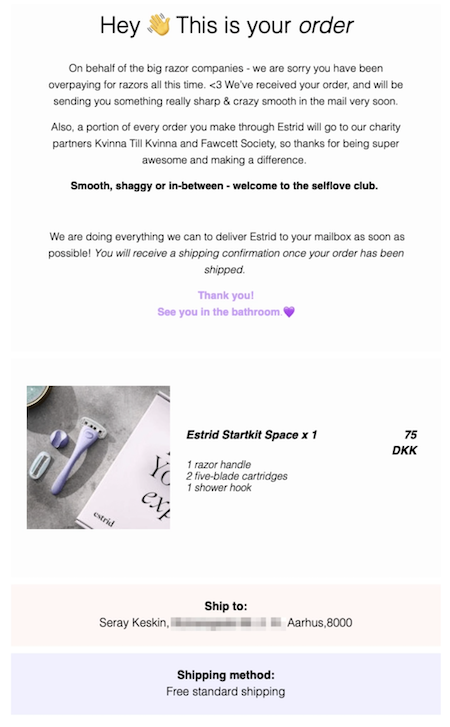
Source: Drip
3. Shipping confirmation email
An order confirmation is wonderful to receive, but most people especially look forward to receiving that all-important notification that their order is finally on its way to their doorstep. In fact, Omnisend states that these messages have an open rate of a whopping 68.2%!
Once the order has shipped, customers receive a shipping confirmation email. This email usually includes a tracking number and estimated delivery date, allowing customers to follow the progress of their shipment.
Just like with order confirmation emails, shipping confirmation emails are generally expected by online shoppers. Besides featuring the customer's order details, these messages should include an expected delivery date if possible and a CTA that makes it possible for the reader to track the order.
For inspiration with this kind of message, here's an example from Onyx Coffee Lab. The company informs the reader when they can expect their package as well as who will be delivering it (USPS). The email also features a summary of the order and tracking details with a clear CTA.
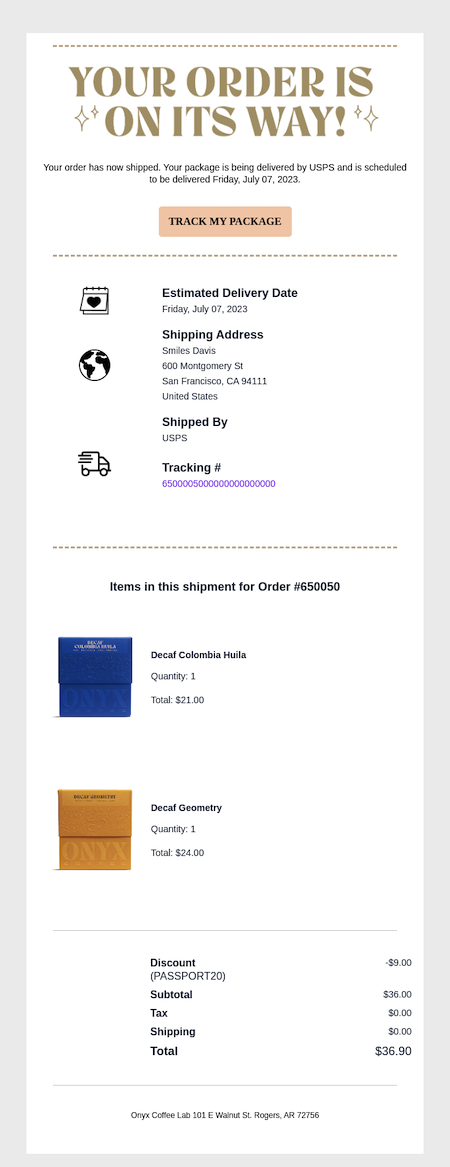
Source: Really Good Emails
4. Delivery confirmation email
Although not obligatory, the sending of delivery confirmation messages will likely be very much appreciated by your customers.
Sent when the order has been delivered, this email confirms that the product has reached the customer. It can also serve as a prompt for the customer to verify the integrity of the product received.
Delivery confirmation emails are highly effective for satisfying shoppers eager to know the exact arrival time of their orders. Particularly beneficial if your store faces lengthy shipping durations or is experiencing delays at present, this kind of communication can give extra reassurance to customers who are anxiously waiting for their purchases.
In this delivery confirmation sent by soap company Dr. Squatch, for instance, the email content informs the recipient where the package was delivered, offers a reminder of what was purchased, and includes a CTA button so that the shopper can track the order if needed. Furthermore, Dr. Squatch explains how to get in touch if the order has yet to arrive.

Source: Really Good Emails
5. Educational email
Depending on the types of products you sell, it's possible that people might require a bit of extra clarification as to how to use these items. And even if your offerings are pretty self-explanatory, it never hurts to give customers tips to guide them in being able to take full advantage of their purchases.
For this reason, you may want to send educational or how-to emails as post-purchase follow-up communication.
This kind of email can cover a wide range of topics, from the best ways to care for a product to instructions on using or assembling it. Including this type of communication can not only boost the likelihood of repeat purchases but also reduce the chances of customers returning their new item.
When brainstorming ideas for useful how-to content, always consider your audience's existing knowledge. Identify areas where they may lack information about your product and fill those gaps. As an expert in your industry, consider the valuable advice you can provide to them, whether in the form of a how-to-video series, links to existing blog posts on your website, or easy-to-digest infographics.
Here's a good example of an educational email by the luggage brand Away. The message features simple instructions on how to use certain features on an item. It also provides links to video tutorials for more detailed explanations.

Source: Really Good Emails
6. Feedback request email
A few days after the product has been delivered, sending a feedback request email can be beneficial. This type of email asks customers for their opinions on the product and the shopping experience, providing valuable insights that can help improve services and products.
What's more, requesting feedback on a previous purchase demonstrates to your buyers that you value their opinions, enhancing customer satisfaction and loyalty.
When asking for shoppers' thoughts and evaluations in an email, be concise and direct, personalize the message, and make it easy for them to respond by including a simple link or form. Offering a small incentive, like a discount on future purchases, can also increase the likelihood of receiving feedback.
Software company MacPaw does a good job requesting feedback in the following email. The message asks the recipient to complete a short survey and even gives an indication of approximately how much time it should take to do so. The brand also gives a discount on other offerings to sweeten the deal for the customer.
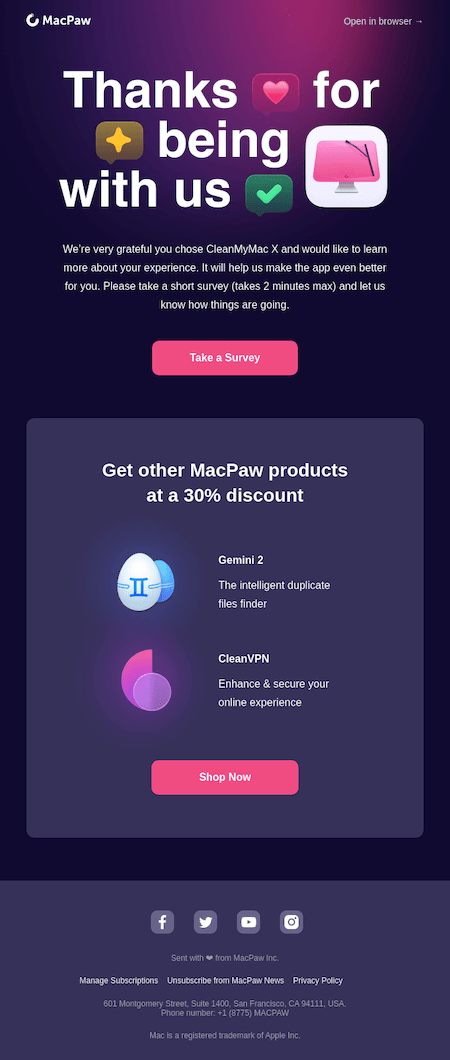
Source: Really Good Emails
7. Review request email
Similar to feedback requests, emails featuring requests for reviews specifically ask customers to leave a review on the website or a third-party platform. Reviews not only influence other potential customers but also enhance the credibility and visibility of the products.
To effectively ask for reviews, send a personalized email thanking customers for their purchase and explaining how their evaluation helps. Include a direct link to where they can leave a review, and ensure that the process is straightforward and quick.
As you schedule your post-purchase email requesting a review, note that it's important to time it for after the product has been delivered and the customer has had an opportunity to use it, rather than just after it has shipped. Sending it too early could lead to requesting feedback on a product the customer hasn't even received yet.
In this review request email sent by Target, the company emphasizes how important the customer's product review is for assisting other people in their shopping decisions. In addition, Target lessens the chances of negative commentary by indicating how the recipient can get help with any problems they have with their order before leaving a review.
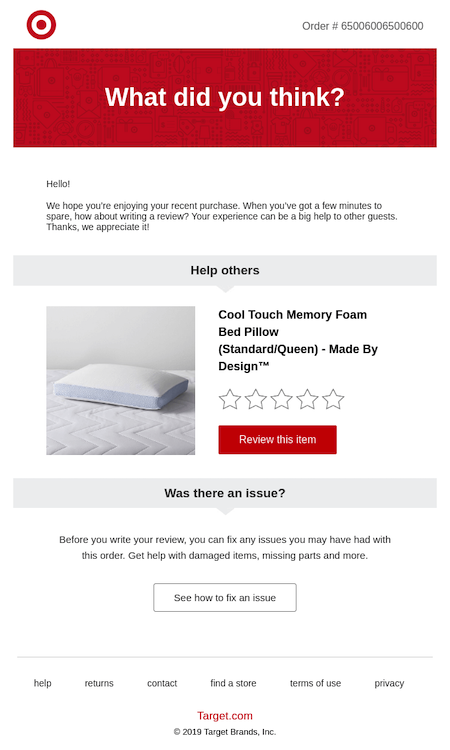
Source: Really Good Emails
8. Cross-sell or upsell email
Once your customer has had the opportunity to use their new product, they'll hopefully be very satisfied with both the item and your brand, increasing the likelihood that they will shop with you again. Furthermore, since you already know what types of products interest this consumer, you can tailor your content to be highly relevant to their preferences.
A cross-sell email entails suggesting products that complement customers' recent purchases. In contrast, the objective of an up-sell email is to encourage customers to purchase higher-end, upgraded, or premium versions of items to increase revenue. Together, these strategies form potent components of post-purchase email automation.
Based on the initial purchase, these emails promote related or complementary products that might interest the shopper. This strategy helps increase the average order value and enhances customer satisfaction by providing useful recommendations.
See cross-selling/upselling in action in this email by Crate & Barrel. After thanking the recipient for their recent order, the company suggests a variety of goods that they may like to buy next. This list of recommendations has been personalized according to what the shopper purchased previously.
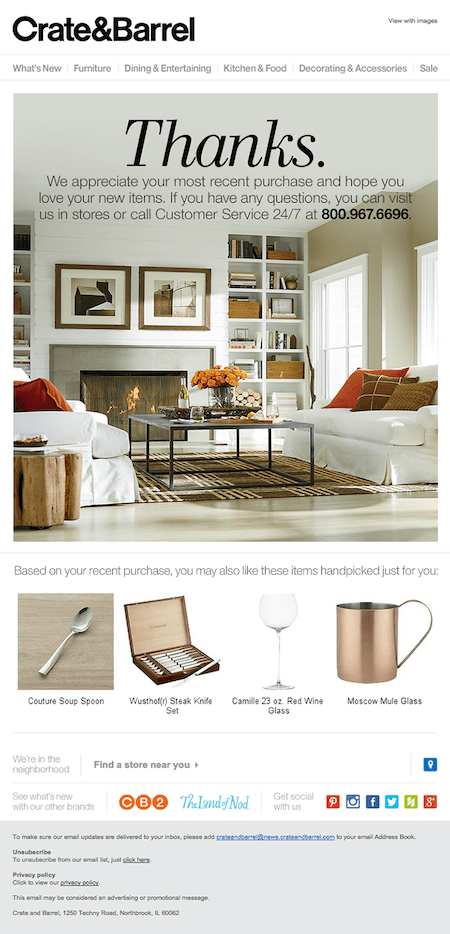
Source: Really Good Emails
9. Loyalty program email
Inviting customers to join a loyalty or rewards program after a purchase can significantly enhance customer retention by offering rewards that encourage repeat business. This gesture shows appreciation and builds a stronger relationship with your customers.
When inviting customers to sign up for your loyalty program via email, focus on the benefits that they'll receive, such as exclusive discounts, early access to new products, or points for future savings.
Keep the invitation clear and compelling, and include a straightforward CTA button that makes signing up simple and quick. Personalize the message to reflect their recent purchase or interests, enhancing the perceived value of joining.
Get inspired for your future communication inviting shoppers to sign up for your loyalty program with this message from supplement company GEM. The recipient gets a step-by-step explanation of how the program functions, a clear description of the various tier-based perks, and several CTAs to make it easy to join.

Source: Really Good Emails
10. Win-back email
While some people who buy from your store may instantly become loyal shoppers, returning time and time again, others may need a bit of extra convincing.
Winning back customers after a purchase involves re-engaging those who may have drifted away. Offering a discount or special promotion through email can effectively prompt them to return for a second purchase.
For the best chance of success with your win-back emails, personalize the message by referencing their previous purchases and expressing a desire to see them again. In addition, highlight the exclusive nature of the offer to make them feel valued.
Don't forget to also ensure that the discount or promotion is compelling enough to trigger action, such as a significant percentage off the shopper's next purchase or a special bundle deal.
Here's an example of a win-back email by Blue Apron. The message reiterates the advantages of the company's offerings, includes an enticing discount, and features a CTA button to guide the recipient back to the website.
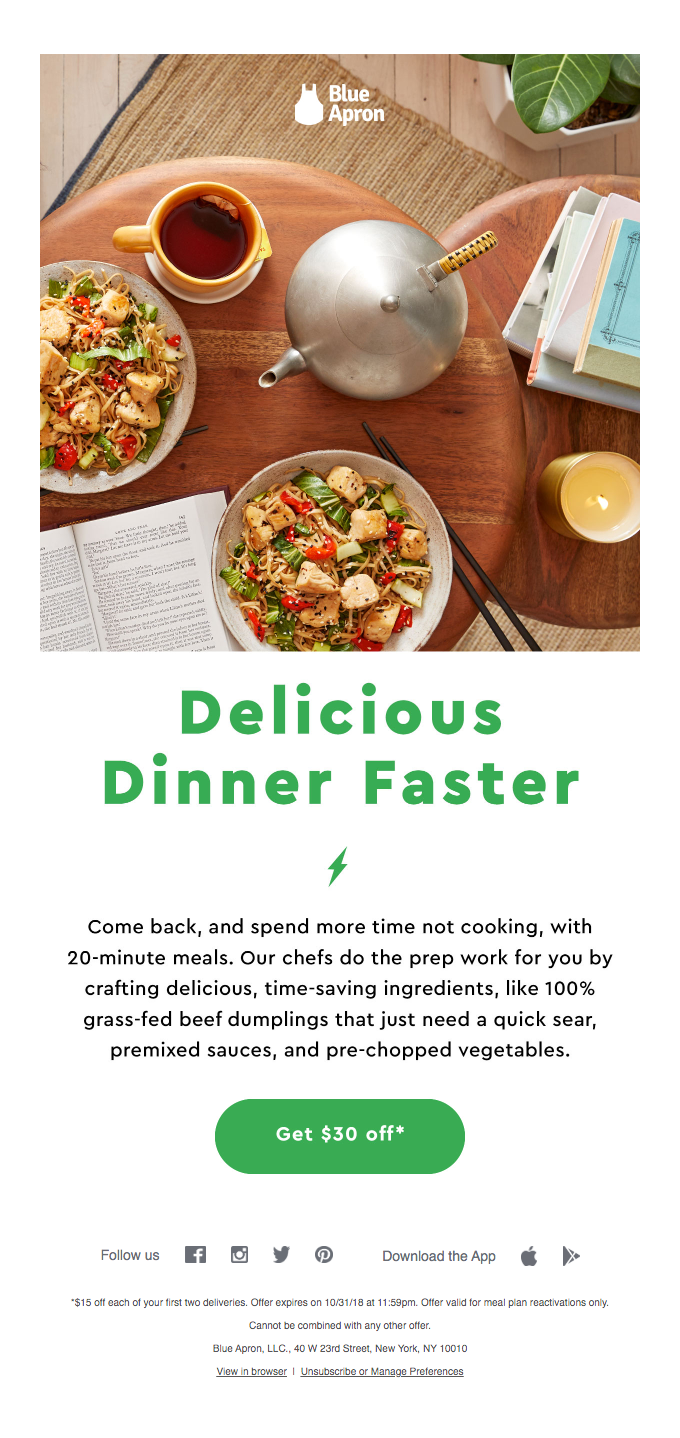
Source: Really Good Emails
11. Seasonal or milestone email
Seasonal or milestone emails are excellent for post-purchase communication because they tap into the personal and cultural moments important to customers.
By acknowledging significant events like holidays, birthdays, or anniversaries of their first purchase, you create a more personalized and memorable experience. This strengthens the emotional connection with the brand and can drive repeat business.
To ensure that these celebratory messages are a hit with shoppers, be sure to tailor the email to reflect the customer's previous interactions with your brand. Use data to personalize messages, such as mentioning products they’ve bought before or services they’ve shown interest in.
You can also incorporate visually appealing elements that are thematic to the occasion, using seasonal graphics, festive colors, and dynamic layouts to make your emails more engaging. Don't hesitate to create a sense of urgency and emphasize the limited-time nature of any offers to incite quick action. Phrases like "limited time only" or "offer ends soon" can increase the effectiveness of your CTA.
In this example of an effective celebratory message, Nintendo wishes the customer a happy birthday. Besides featuring colorful graphics and a personalized birthday greeting, the email includes a special discount code to be used for a later purchase.

Source: Really Good Emails
Post-purchase email benchmarks
By this point, you've probably come to understand that well-crafted post-purchase emails are crucial for your brand's marketing strategy. However, you may be curious about how well these kinds of emails perform on average.
For some interesting insights into the performance metrics typically seen with post-purchase ecommerce emails, take a look at the Q4 2022 benchmarks for various industries, as determined by Klaviyo data.
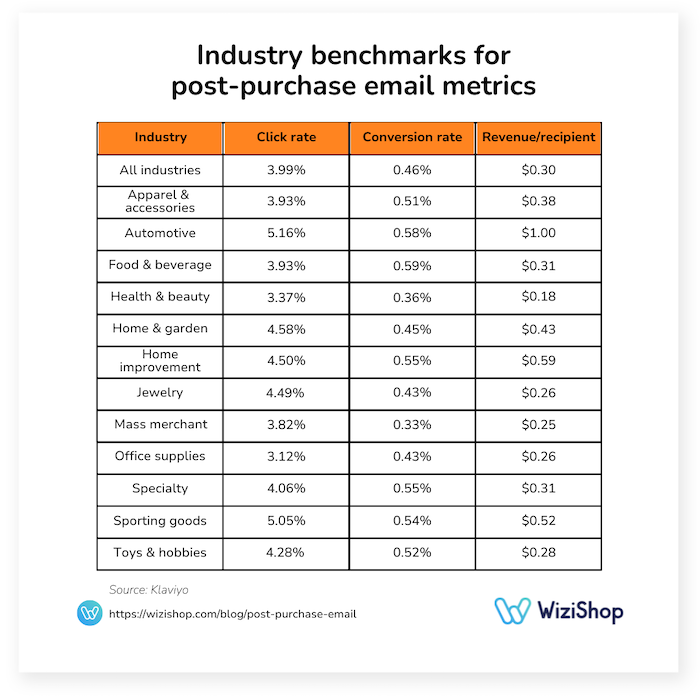
Remember that in contrast to, say, abandoned cart emails, for example, which aim to prompt an immediate purchase, your post-purchase email campaigns will primarily focus on nurturing customers and providing information about a recent order. This in turn can help build loyalty and encourage additional purchases down the road.
As these messages are part of a long-term strategy, don't worry if you see lower click rates, conversion rates, and revenue per recipient—they're completely normal!
Best practices for post-purchase email campaigns
Effective post-purchase email campaigns are a crucial aspect of ecommerce marketing, helping to enhance customer relationships and boost business growth.
By adhering to the following best practices, brands can create post-purchase email campaigns that will not only enhance the customer experience but also contribute to increased customer retention, loyalty, and overall sales.
Avail of customer segmentation
Segmenting customers for post-purchase emails allows for personalized communication tailored to different customer needs and behaviors, which can significantly enhance customer satisfaction and loyalty.
You can segment your brand's customers based on several criteria, such as purchase history (frequency, type, and value of products bought), demographic information, geographical location, and engagement levels (e.g., customers who frequently open emails versus those who don't).
Personalize your messages
To forge a stronger bond with shoppers, go beyond using the customer’s name. Tailor the content based on their purchase history, preferences, and behaviors.
Personalization can include specific product recommendations, personalized discounts, or even a custom message that relates to their recent purchase. This approach shows that you value them as individuals, increasing engagement and loyalty.
Include clear and concise content
There's a good chance that many people in your audience receive multiple emails from different brands in their inbox everyday, and they won't want to spend hours reading each one.
Ensure that your emails are easy to read and get to the point quickly. Use clear headings, bullet points, and short paragraphs. Provide all necessary details like order numbers, tracking information, and customer service contact info prominently.
An effective post-purchase email should communicate the essential information efficiently without overloading the customer with unnecessary details.
Add a strong call to action (CTA)
Each email should have a clear objective and a strong CTA that encourages the customer to take the next step.
Whether it’s tracking their order, leaving a review, exploring related products, or taking advantage of a special offer, your CTA should be prominently placed and easy to understand. For example, buttons like "Track Your Order," "Write a Review," or "Shop Similar Products" are direct and effective.
Optimize for mobile
With the increasing use of mobile devices to read emails, it's crucial to ensure that your post-purchase emails are mobile-friendly.
This includes responsive design that adapts to different screen sizes, large enough fonts to read on small screens, and touch-friendly buttons and links. A mobile-optimized email ensures a smooth user experience, which can significantly affect how customers perceive your brand.
When should you send post-purchase emails?
Timing is key in post-purchase communication!
For instance, you'll want to send order confirmation emails immediately after purchase to reassure customers. Follow up with a shipping confirmation email once the item is dispatched. Schedule feedback or review request emails appropriately—usually a few days after the product is expected to have been received, giving customers enough time to evaluate the product.
Finally, be mindful not to overwhelm customers with too many emails, which can lead to unsubscribes.


